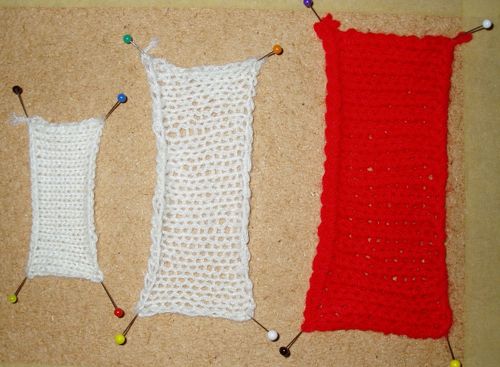
Although we all know that with the same yarn small needles will produce a smaller piece of knitting than bigger needles will, and likewise using the same needles with a fine yarn will make a smaller piece of knitting than a thick yarn will, but what is the relationship between length of yarn and area of knitting when using different yarns or needles?
I knitted three test swatches, wetted and blocked them and then made a few measurements. Each swatch was 20 stitches wide, long-tail thumb method cast on, 11 rows of knitting and regular cast off, making a total of 280 stitches.
The yarns I used were King Cole Zig-Zag 4 ply which I measured at 21 wraps per inch and an unknown Aran weight acrylic which I measured at 14 wraps per inch.
(Ravelry suggest that 4 ply is 14 wpi and Aran is 8 wpi but I can never measure as few wraps as they suggest.)

| 4 ply - 2mm needles | 4 ply- 4 mm needles | Aran - 4mm needles | |
|---|---|---|---|
| width of 10 sts | 3.4 cm | 5.8 cm | 6.8 cm |
| Depth of 10 sts | 2.4 cm | 3.7 cm | 4.0 cm |
| Area of 100 sts | 8.18 sq cm | 21.46 sq cm | 27.2 sq cm |
| Length of yarn for 280 sts | 2.38 m | 5.06 m | 5.89 m |
| Length of yarn for 100 sts | 0.85 m | 1.81 m | 2.10 m |
| Area covered by 1m of yarn | 9.62 sq cm | 11.86 sq cm | 12.95 sq cm |
Whilst just three swatches and sets of results does not constitute a proper scientific experiment it does suggest that increasing the needle size has more effect on the size of a piece of knitting than increasing the thickness/diameter of the yarn.